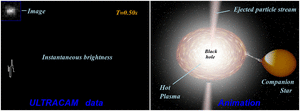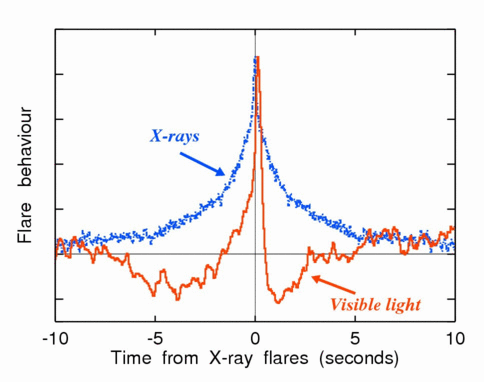VLT and X-ray satellite join forces to probe flickering black holes
- 15 October 2008 -
Click =>here for ESO press release<=
Click =>here for NASA news feature<=
Click =>here for RIKEN press release (Japanese only)<=
Like a candle flame, the light from a black hole is not constant -
it flares, sputters and sparkles. New observations of the flickering
radiation from two black holes have tested theories about the colossal
energy flows at their hearts. By mapping out how well the variations in
light visible to the human eye match the variations in X-rays on very
short timescales, astronomers have shown that magnetic fields must play
a crucial role in the immediate environment around black holes.
The rapid flickering of light from a black hole is most
commonly observed at X-ray wavelengths. This new study is one of only a
handful to date that also explore the fast variations in the optical
light, and, most importantly how these fluctuations relate to those in
the X-rays. The observations tracked the shimmering of the black holes
simultaneously with two different instruments. The optical light was
collected with the novel high-speed camera ULTRACAM at the European
Southern Observatory's Very Large Telescope (VLT), recording up to 20
images a second. The X-ray data were taken using NASA's X-ray satellite
the Rossi X-ray Timing Explorer.
To their surprise, the astronomers discovered that the brightness
fluctuations in the visible light were even more rapid than those seen
in the X-rays. In addition, the optical and X-ray variations were found
not to be simultaneous, but to follow a repeated and remarkable
pattern: just before an X-ray flare the optical light dims, and then
surges to a bright flash for a tiny fraction of a second before rapidly
decreasing again (see figure below). Why is this pattern important?
None of this radiation emerges directly from the black hole, but from
the intense energy flows of charged matter generated in its vicinity.
Black hole environments are constantly being reshaped by a riotous
melee of strong and competing forces such as gravity, magnetism and
explosive pressure. As a result, light emitted by the hot flows of
matter varies in brightness in a muddled and haphazard way. But the
pattern found in this new study possesses a stable structure which
stands out amidst otherwise chaotic variability; so, it can yield vital
clues about the dominant underlying physical processes in action.
The optical emission from black holes neighbourhoods was widely thought
to be a secondary effect, with a primary X-ray outburst illuminating
surrounding gas which subsequently shone in the visible range. But in
such a case, any optical variations would lag behind the X-ray
variability, and would be much slower to peak and fade away. The rapid
optical flickering now discovered immediately rules out this scenario
for both systems studied. Instead the variations in the X-ray and
optical light output must have some common origin, and one very close
to the black hole itself.
Strong magnetic fields represent the best candidate for the dominant
physical process. Acting as a reservoir, they can soak up the energy
released close to the black hole, storing it until it can be discharged
either as hot (multi-million degree) X-ray emitting plasma, or as
streams of charged particles travelling at close to the speed of light.
The division of energy into these two components can result in the
characteristic pattern of X-ray and optical variability.
Supplementary Information
The two black holes GX 339-4 and SWIFT J1753.5-0127 are the remnants of
massive dead stars in the Milky Way. They are embedded in separate
'binary' stellar systems, where the black hole is locked
gravitationally into an orbit with a normal star. Both black holes have
masses of around ten times that of our Sun, yet the size of their
orbits is only a few million kms, much more compact than the orbit of
Mercury around our Sun.
ULTRACAM is supported by a UK STFC grant PP/D002370/1. RXTE
(Rossi X-ray Timing Explorer) is operated by NASA. This work was based
on observations at the Very Large Telescope (ESO programs 079.D-0535
and 279.D-5021) and RXTE cycle 12 (program 93119). Published in the
following two Journal Letters :


